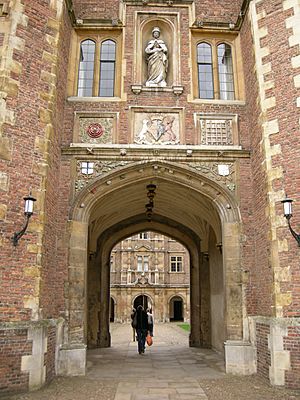Mary Talbot, Countess of Shrewsbury facts for kids
Mary Talbot, Countess of Shrewsbury (1556–1632), born Mary Cavendish, was an important English noblewoman. She was known for her strong will and intelligence, much like her famous mother, Bess of Hardwick. Mary played a part in some exciting events during the reigns of Queen Elizabeth I and King James I.
Quick facts for kids Mary Talbot |
|
|---|---|
| Countess of Shrewsbury | |
| Spouse(s) | Gilbert Talbot, 7th Earl of Shrewsbury |
| Issue | |
| George Talbot Mary Talbot, Countess of Pembroke Elizabeth Talbot, Countess of Kent John Talbot Althea Talbot, Countess of Arundel |
|
| Noble family | Cavendish |
| Father | William Cavendish |
| Mother | Bess of Hardwick |
| Born | 1556 |
| Died | 1632 |
Her Family and Early Life
Mary Cavendish was born in 1556. Her father, Sir William Cavendish, passed away when she was only about one year old. Her mother was the famous and very wealthy Bess of Hardwick. People said that Mary inherited her mother's strong personality and lively spirit.
After Mary's father died, her mother, Bess, married Sir William St. Loe. When he died in 1564 or 1565, he left everything to Bess. This made her one of the richest and most sought-after women in England. Many important men wanted to marry her, including George Talbot, 6th Earl of Shrewsbury.
To make sure everyone benefited, Bess agreed to marry the 6th Earl of Shrewsbury. As part of the deal, her daughter Mary Cavendish would marry the Earl's second son, Gilbert Talbot. Also, the Earl's daughter Grace would marry Bess's son Henry Cavendish. These marriages happened in 1568. Mary was not yet twelve years old when she got married. Her mother and the Earl married soon after.
Her Marriage and Children
Mary married her stepbrother, Gilbert Talbot, in 1568. Gilbert later became the 7th Earl of Shrewsbury.
Mary and Gilbert had several children:
- George (1575–1577)
- Mary, who later became the Countess of Pembroke
- Elizabeth, who later became the Countess of Kent
- John (born and died in 1583)
- Alethea, who later became the Countess of Arundel
In 1607, Mary, Gilbert, and Mary's brother Charles Cavendish visited Hardwick Hall to see Bess of Hardwick. Gilbert wrote that Bess was "a lady of great years, of great wealth, and of a great wit, which yet still remains."

Mary Talbot was a generous supporter of learning. She helped pay for the building of the Second Court at St John's College, Cambridge. There is even a statue of her on the gatehouse of the college, showing how important her support was.
Trouble and Imprisonment
Even though her family was Anglican Protestant, Mary became a Catholic when she grew up. This might have been one reason why she helped her niece, Arbella Stuart, in 1610. Arbella was a cousin of King James I of England and had a claim to the throne. Mary knew that Arbella planned to run away to Europe with her cousin William Seymour.
This marriage would have made King James I very angry. Both Arbella and William Seymour had claims to the throne, and their marriage could have caused problems for the King. Arbella and Seymour tried to escape to France in 1611. Because she helped them, Mary was sent to the Tower of London. It was said that when they were questioned, Arbella stayed calm, but Mary cried out, "All is but tricks and giggs!"
Mary was put on trial for her part in the escape. She was given a large fine but was not released from prison. Later, Arbella even accused Mary of being involved in a Catholic plot. It's hard to know exactly why Mary helped Arbella. Even though Mary was Catholic and cared for her niece, she was smart enough to know the serious risks involved. Perhaps she thought her husband's influence would save her. Like her mother, Mary was one of the few women of her time who was used to getting her own way.
Mary was very upset when Arbella died in 1615. She had been told that Arbella was getting better, and she couldn't stop thinking about it. She even imagined she had been poisoned and was treated by a doctor for her sadness.
In 1615, Mary was finally released from the Tower. This was partly because she helped uncover the murder of Sir Thomas Overbury. It was also because her husband was very ill. In 1618, she was asked to give evidence about rumors that Arbella had secretly had a child. Mary refused to speak, saying she had sworn an oath not to. So, she was sent back to the Tower, where she stayed until 1623. She had the best rooms there! Mary was not easily scared. The writer Dorothy L. Sayers described her as "uncontrollable by her menfolk, undaunted by the Tower, and contemptuously silent before the Privy Council." Francis Bacon, a famous writer and statesman, once said that while Lord Shrewsbury was a "great person," there was "a greater than he, which is my Lady of Shrewsbury." This shows how powerful and respected Mary was.
In Fiction
Mary Talbot's strong character is briefly shown in the mystery novel Gaudy Night by Dorothy L. Sayers. The story takes place at Shrewsbury College, a made-up Oxford college named after her. The main character, Harriet Vane, looks at a portrait of Lady Shrewsbury. She wonders why the college chose "so ominous a patroness… a great intellectual certainly, but something of a holy terror."

